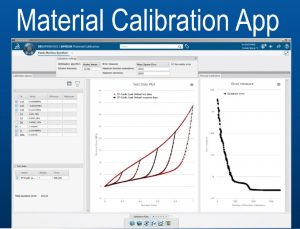Originally published on January 17, 2019.
There is a new material model calibration app that was recently delivered as part of the 3DEXPERIENCE Platform, 2018x FD03. A key challenge in using the advanced material models in Abaqus is knowing what testing to perform on a material specimen and how to calibrate a material model to obtain a good set of model parameters (coefficients).  Calibration is an enabling technology that allows our customers to use better, more advanced, material models to describe their materials. Calibration tools help Abaqus users build higher fidelity models, with more physical realism.
Calibration is an enabling technology that allows our customers to use better, more advanced, material models to describe their materials. Calibration tools help Abaqus users build higher fidelity models, with more physical realism.
To address this issue a new role has been created, Material Calibration Specialist that consists of the calibration app and the material definition app (material editor). You will find attached to this post a short set of PowerPoint slides that describe the calibration app, and a series of narrated videos showing the use of the app for a few different material models. The goal of this initial release is to provide a very fast and highly visual tool with coverage that meets or exceeds what is available today in Abaqus/CAE. In this initial release of the calibration app, there is no use of the Abaqus solver. There is instead a mathematical kernel that takes the test data and finds the material model response to a deformation and carries out optimization to determine the best fit set of model parameters. Future releases will continue to add coverage for most, or all, of Abaqus material models. As the PowerPoint slides describe, calibration can go well beyond material constitutive behavior to damage & failure and even modeling abstractions such as connector element constructs for fasteners and bushings. We also know there is a need for calibrating behaviors with multi-element meshes/models for cases of non-homogeneous physics (localization, damage, etc.).

One very significant piece of technology that we have delivered in this first release is that the hyperelastic + Prony series calibration is performed as an integrated and simultaneous calibration (with hereditary integrals). This means, as a for instance, that test data from a family of rates curves can now be calibrated. This was never possible before with Abaqus/CAE tools.
Want to view the demo videos and slides to learn more? Visit the SIMULIA Learning Community for more content!
SIMULIA offers an advanced simulation product portfolio, including Abaqus, Isight, fe-safe, Tosca, Simpoe-Mold, SIMPACK, CST Stuido Suite, XFlow, PowerFLOW and more. The SIMULIA Learning Community is the place to find the latest resources for SIMULIA software and to collaborate with other users. The key that unlocks the door of innovative thinking and knowledge building, the SIMULIA Learning Community provides you with the tools you need to expand your knowledge, whenever and wherever.
